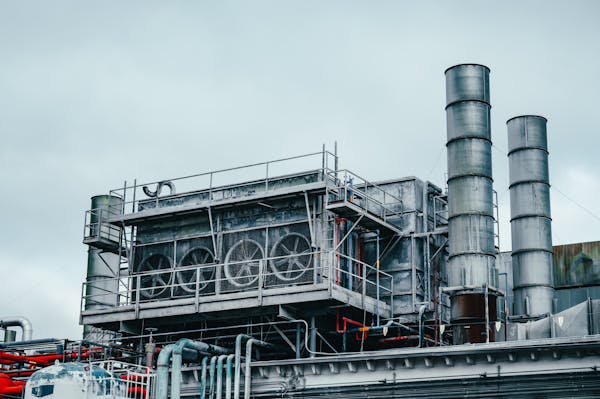Table of Contents
Machines have significantly transformed our world, from steam-powered engines during the Industrial Revolution to advanced silicon-based technologies, influencing every aspect of society.
The Birth of Steam Power
The Industrial Revolution, which began in the late 18th century, saw the introduction of steam power, which revolutionized various activities, including manufacturing and transportation. Steam engines, such as the steam locomotive, revolutionized transportation by enabling quicker movement of goods and people, and enhancing productivity in factories. This era marked the beginning of large-scale industrialization and laid the groundwork for future technological advancements.
The Rise of Electric Power
Electric power emerged as a new frontier in industrial machinery in the late 19th and early 20th centuries, improving efficiency and enabling finer control over machinery. Nikola Tesla and Thomas Edison promoted this advancement, which dominated industry and domestic life. This led to the creation of the electric grid, making power readily available and transforming daily life.
The Advent of Computers
The development of computers marks a significant milestone in the history of industrial machines. Initially, early computers were primarily utilized for military and scientific calculations. However, as technology progressed, these machines found their way into everyday business operations. The 1950s and 1960s saw the production of the first commercially available computers, which were instrumental in managing complex industrial processes. Computers enabled automation, allowing machines to perform tasks with minimal human intervention. This period also marked the birth of computer numerical control (CNC) machines, which used computed inputs to accurately produce intricate parts, revolutionizing manufacturing industries.
Silicon and Microprocessors
The advent of silicon and the development of microprocessors revolutionized industrial machinery. Microprocessors, tiny chips made of silicon, became the brains of numerous devices. These processors enabled machines to perform more complex tasks with greater efficiency and precision. The 1970s and 1980s saw the widespread adoption of these technologies in industrial applications. Machines could now be programmed to perform an array of functions, leading to significant advancements in automation and control systems. The rise of microprocessors also paved the way for the development of personal computers, further enhancing business processes and productivity on an unprecedented scale.
Robotics and Automation
With the help of robotics and automation, industries can now achieve levels of efficiency previously thought impossible. Robots, often controlled by complex software and equipped with advanced sensors, can perform repetitive tasks with high precision. This technology finds applications in various sectors, from automobile manufacturing to electronics assembly. The rise of automation has not only improved productivity but also ensured higher safety standards by reducing human intervention in hazardous environments. Additionally, robots and automated systems can work continuously without fatigue, further boosting output. The ongoing advancements in artificial intelligence and machine learning promise to make industrial robots even smarter and more adaptable in the future.
The Internet of Things (IoT)
The Internet of Things (IoT) represents a paradigm shift in the way industrial machines operate. By connecting machines to the internet, IoT enables real-time data collection and analysis, facilitating better decision-making and predictive maintenance. Sensors embedded in machinery can monitor various parameters like temperature, pressure, and wear, sending data to central systems for analysis. This connectivity allows factories to run more efficiently by identifying problems before they cause breakdowns, thus minimizing downtime. Furthermore, IoT opens new opportunities for remote monitoring and control, enabling experts to manage machines from virtually anywhere. As IoT technology continues to evolve, its influence on industrial machinery will only grow.
Sustainable and Green Technologies
Modern industrial machines are increasingly being designed with sustainability in mind. The focus is shifting towards energy-efficient systems that reduce carbon footprints. Innovations like electric and hybrid vehicles, solar-powered machinery, and waste-reducing manufacturing processes are shaping the future of industrial operations. Sustainable technologies aim to meet current industrial needs without compromising the ability of future generations to meet theirs. Recycling and waste management systems integrated into manufacturing processes further contribute to a more sustainable practice. Through these advancements, industries are not only becoming more efficient but also more responsible, playing a crucial role in the global effort to combat climate change.
Conclusion
From steam to silicon, the transformation of industrial machines has reshaped industries and societies globally. Steam engines kick-started industrialization, paving the way for multiple groundbreaking advancements. The rise of electricity and the advent of computers further accelerated industrial efficiency and productivity. Silicon and microprocessors introduced complex automation capabilities, leading to smarter machines and the birth of the information age. Robotics and automation brought unprecedented precision and safety, while IoT enabled real-time monitoring and predictive maintenance. Lastly, sustainable technologies are steering industries toward a more eco-friendly future. As technology continues to evolve, the impact and influence of industrial machines will keep shaping our world in ways we can only imagine.

